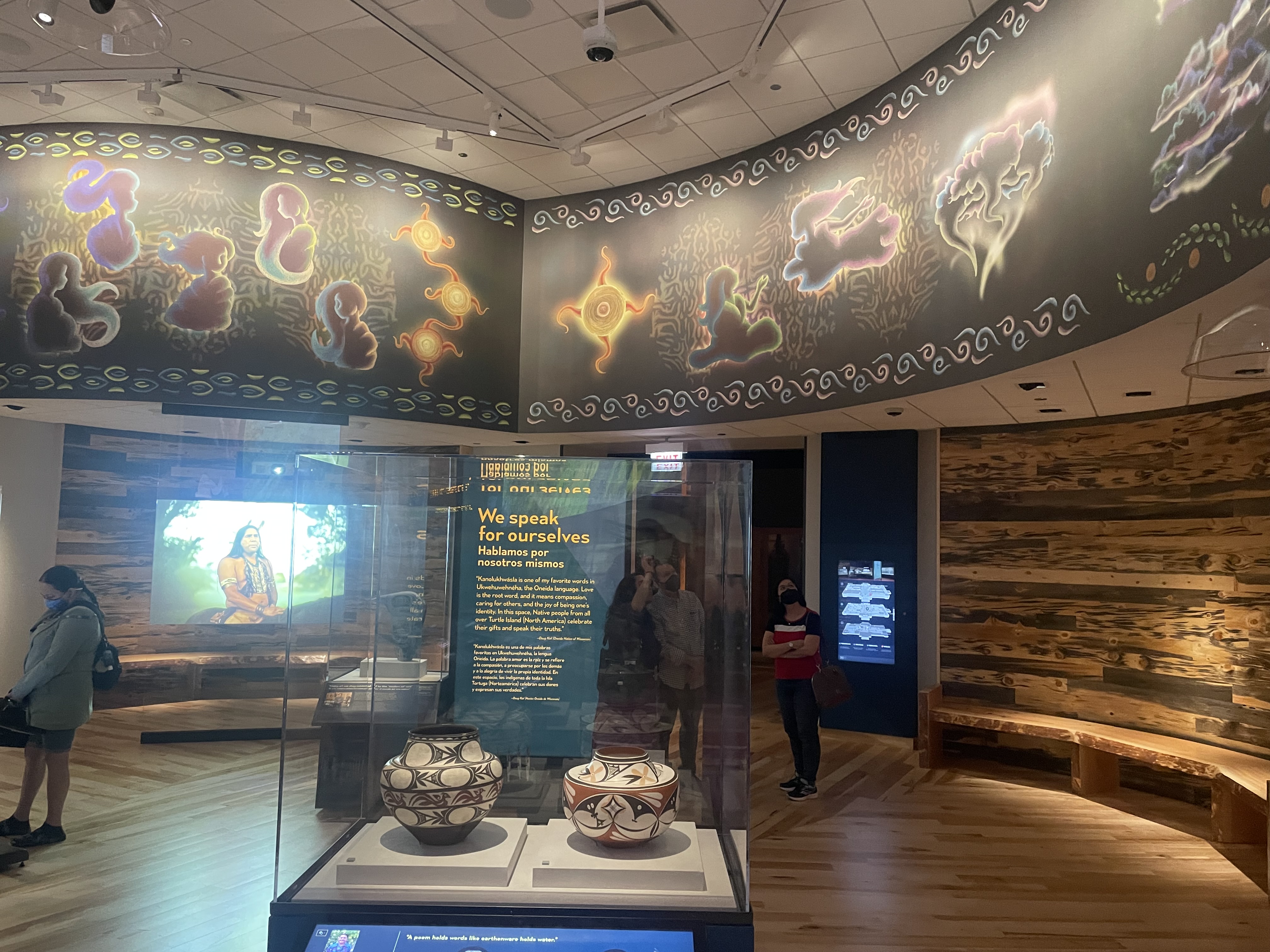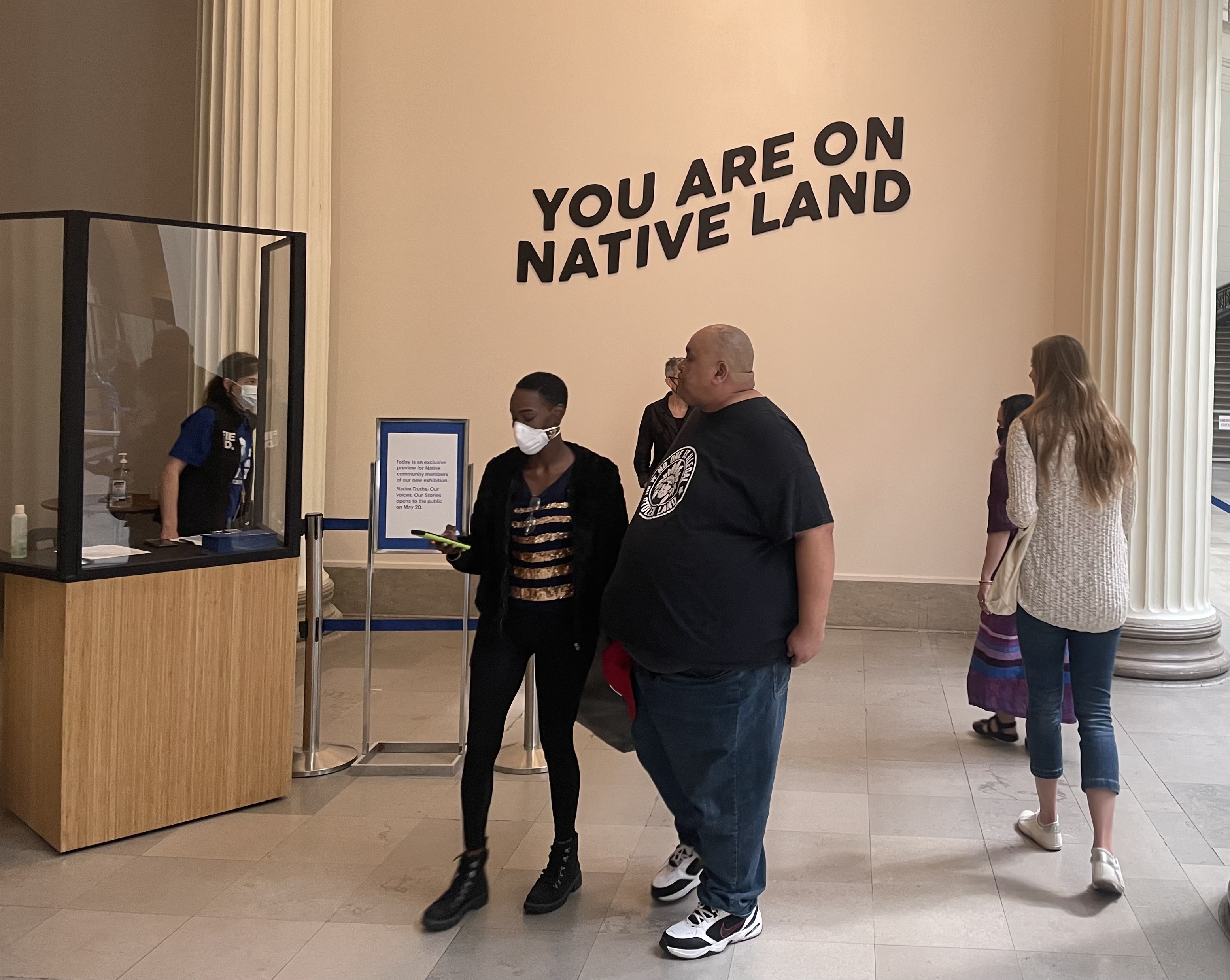
- Details
- By Levi Rickert
CHICAGO — The Native American community was afforded a sneak preview on Saturday of the new Native Truths: Our Voices, Our Stories exhibition at the Field Museum in Chicago.
The exhibition is filled with of colorful art and videos and informative narrative panels that depict the vibrancy of contemporary Native Americans. This exhibit replaces a Native American exhibit that was opened during the 1950s.

From the comments from some of the Native Americans who toured the Native Truths exhibit, the Field Museum did not disappoint.
Caitlin Jacobs (Lumbee Tribe of North Carolina), a medical student at Northwestern, was impressed. “I just felt like it was about time, and it's really nice to see it all come together. And I appreciate how much diversity there is in the types of exhibits because I feel like it could have easily gone with just, like, the Great Lakes," Jacobs said.
Starla Thompson (Forest Band of Potawatomi) feels it is time for Native Americans to tell their own stories. She feels Native Truths accomplished this.
“Telling our stories is really important and something that hasn't been done. And I was hoping that that's what I would see here today, is an accurate telling of our stories from our perspective – not from an anthropologist’s perspective or a museum's perspective – and so far, that's what I've seen. It's Indigenous people telling their stories, their culture, their family stories. That' s really precious," Thompson commented. “Indigenous people see those [artifacts] as relatives, and they’re alive. They're alive and they’re living. So it's a whole different way to look at the world.”
Other comments:
Michaela Marchi (Isleta Pueblo, Filipina and Italian):
“I am excited to see that change has begun, and that more contemporary voices and perspectives in the Native community and Indigenous community in not only Chicago but all around the country and beyond are being better told and honored and respected in a new way that I hope continues to affect the ways they do exhibitions here at the Field Museum.”
“Centering all the storytelling, I think [the exhibit] does a really good job. And also bringing contemporary iterations of cultural items and values to the forefront.”
Roberta Alloway (Potawatomi, Beaver Clan):
“To understand that we're still here. We’re not stoic. Our culture does evolve and it does change….There's an understanding that these people that lived here aren’t going anywhere."
The exhibition will be open again to the Native American community on Sunday, May 15, 2022. The exhibit opens to the general public on May 20, 2022.
Kelsey Turner contributed to this article from Chicago.
-
 Basket weaver from Riverside, Calif. shows her artistic talents. Basket weaver from Riverside, Calif. shows her artistic talents.
Basket weaver from Riverside, Calif. shows her artistic talents. Basket weaver from Riverside, Calif. shows her artistic talents. -
 Debra Yepa-Peppan (Jemez Pueblo/Korean), Community Engagement Coordinator for the Native Truths project. Debra Yepa-Peppan (Jemez Pueblo/Korean), Community Engagement Coordinator for the Native Truths project.
Debra Yepa-Peppan (Jemez Pueblo/Korean), Community Engagement Coordinator for the Native Truths project. Debra Yepa-Peppan (Jemez Pueblo/Korean), Community Engagement Coordinator for the Native Truths project. -
 Mary Ellenwood Mary Ellenwood
Mary Ellenwood Mary Ellenwood -
 Dallas Goodtooth, resident of the Chicago area, shown in his role on Rez Dogs. Dallas Goodtooth, resident of the Chicago area, shown in his role on Rez Dogs.
Dallas Goodtooth, resident of the Chicago area, shown in his role on Rez Dogs. Dallas Goodtooth, resident of the Chicago area, shown in his role on Rez Dogs. -
 Turtle Island by Monica Rickert-Bolter (Prairie Band Potawatomi Nation). Turtle Island by Monica Rickert-Bolter (Prairie Band Potawatomi Nation).
Turtle Island by Monica Rickert-Bolter (Prairie Band Potawatomi Nation). Turtle Island by Monica Rickert-Bolter (Prairie Band Potawatomi Nation). -
 Land acknowledgement. Land acknowledgement.
Land acknowledgement. Land acknowledgement. -
 Sherman Indian Boarding School shown in a video in Native Truths. Sherman Indian Boarding School shown in a video in Native Truths.
Sherman Indian Boarding School shown in a video in Native Truths. Sherman Indian Boarding School shown in a video in Native Truths. -
 Art by Monica Rickert-Bolter (Prairie Band Potawatomi Nation) Art by Monica Rickert-Bolter (Prairie Band Potawatomi Nation)
Art by Monica Rickert-Bolter (Prairie Band Potawatomi Nation) Art by Monica Rickert-Bolter (Prairie Band Potawatomi Nation) -
 Visual throughout exhibit connect the past to the present. Visual throughout exhibit connect the past to the present.
Visual throughout exhibit connect the past to the present. Visual throughout exhibit connect the past to the present.
https://nativenewsonline.net/arts-entertainment/sneak-preview-new-native-truths-exhibition-at-field-museum#sigProIde6543e115d
More Stories Like This
Chickasaw Holiday Art Market Returns to Sulphur on Dec. 6Center for Native Futures Hosts Third Mound Summit on Contemporary Native Arts
Filmmakers Defend ‘You’re No Indian’ After Demand to Halt Screenings
A Native American Heritage Month Playlist You Can Listen to All Year Long
11 Native Actors You Should Know
Help us defend tribal sovereignty.
At Native News Online, our mission is rooted in telling the stories that strengthen sovereignty and uplift Indigenous voices — not just at year’s end, but every single day.
Because of your generosity last year, we were able to keep our reporters on the ground in tribal communities, at national gatherings and in the halls of Congress — covering the issues that matter most to Indian Country: sovereignty, culture, education, health and economic opportunity.
That support sustained us through a tough year in 2025. Now, as we look to the year ahead, we need your help right now to ensure warrior journalism remains strong — reporting that defends tribal sovereignty, amplifies Native truth, and holds power accountable.
 The stakes couldn't be higher. Your support keeps Native voices heard, Native stories told and Native sovereignty defended.
The stakes couldn't be higher. Your support keeps Native voices heard, Native stories told and Native sovereignty defended.
Stand with Warrior Journalism today.
Levi Rickert (Potawatomi), Editor & Publisher

